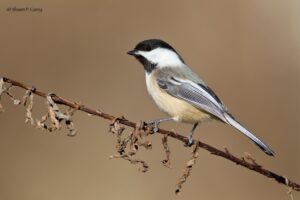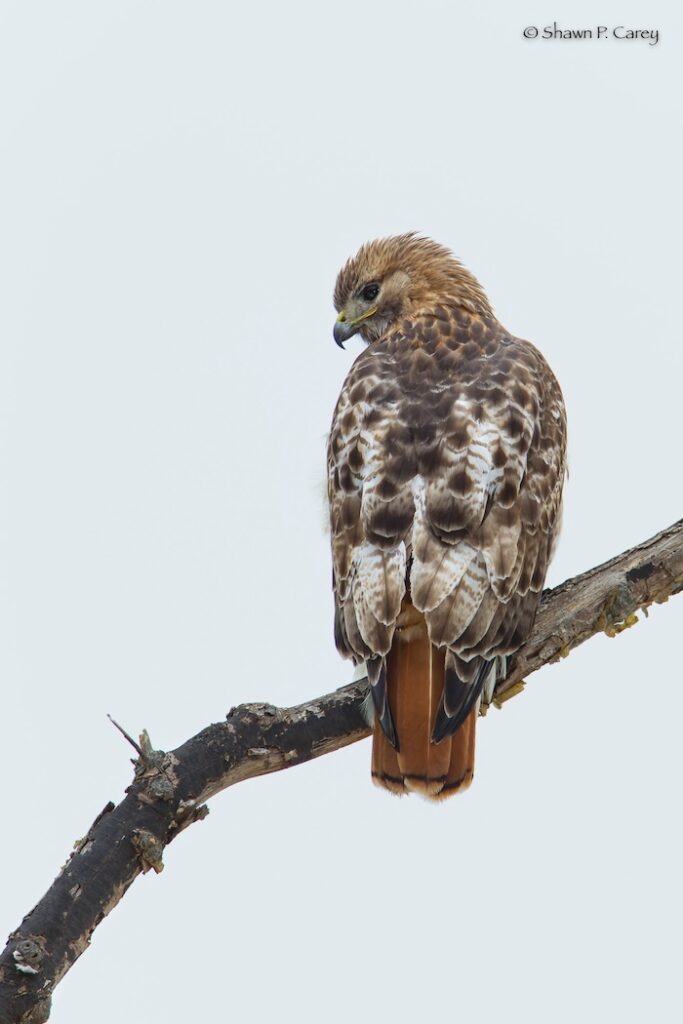
By Fred Bouchard. Photographs by Shawn Carey.
We’ve changed tactics for getting familiar with our bird buddies of the brumal (pre-vernal, i.e., winter) season. We’ll pair like with like—woodpeckers, raptors, songsters, and feeder favorites. For more information, research any species by visiting ebird.org.
Downy Woodpecker / Red-bellied Woodpecker
Woodies are mostly non-migratory. While flickers and sapsuckers head South, the rest abide with us—quite vocally—year-round; in leafless months we get to see them better. Of the five remaining, three mainly stay in forested areas: the mid-sized Hairy, the majestic Pileated (“Woody”) and the rare Red-headed Woodpeckers.
Our likelier winter peckers flit between deciduous tree trunks just about anywhere, seeking grubs in bark crevices, or boring holes for a nut stash or nest. The smaller (6½”) Downy, a backyard and feeder regular, favors suet and oily seeds like sunflower seeds. It has black/white wings and white breast; males sport a red crown spot. Its cry is a single acute ”pik!”, its call a quick, descending half-dozen “pik!”s.
Rare in New England until the 1990s, Red-bellieds emigrated swiftly from southern hardwood lands, and are now permanent, vociferous residents. As big (9”) and bulkier than the Hairy, they’re more noisy, aggressive, and gregarious. Their trilling “churr” and raucous “chaff-chaff!” carry far through woodlot, yard, and wetland. Its name is a misnomer: their bellies are buffy-pink, and the red is limited to males’ crown and nape and females’ cowls.
Black-capped Chickadee / Carolina Wren
When it comes to picking state birds, our fellow countrymen tend to favor the obvious: seven states chose Northern Cardinal, six Western Meadowlark, and five Northern Mockingbird. Only we Bay Staters named Black-capped Chickadee as our official avian mascot; Maine just chose “chickadee”, tacitly including the rare northern Boreal Chickadee.
It’s easy to see why: they’re “smaht,” inquisitive, gregarious, and darn cute in their black hourglass mask over gray and white. Flitting in small packs often at eye level, they dee-dee-dee incessantly, patrol yards, peck at feeders, puzzle out buds, nest in knotholes, even perch (albeit warily) on your palm for a seed. As woodland town criers, chickadees (there are seven regional species nationwide) lead other small birds in their wake to “out” and annoy avian antagonists, from jay to owl. Come spring, they’ll sing their sweet wistful two-note song.
Another captivating personality—and recent Dixieland emigré—is the Carolina Wren. Chunkier, with rustier barring than our homegrown, migratory House Wren, Carolinas sport a wicked white supercilium (eyebrow) and shout wild ringing triplets twee-dle-dum!, with trills and raucous chatter. You’ll hear them first—they’ll roust you before dawn! Both wrens may inhabit nest-boxes, but Carolinas have endured through milder winters. Veteran birder and statistician Bob Stymeist reports, “On the Greater Boston Christmas Count 40 years ago, a highlight was the sighting of a single Carolina Wren; on 2023’s CBC, we had an all-time high of 219!” Compiler Stymeist adds, “Belmont section recorded 19.”
Red-tailed Hawk / Bald Eagle
Red-tails stand out hands down as New England’s commonest diurnal raptor. We see these robust buteos roost in trees, unconcernedly baring their pale streaky breasts, and look you right in the eye. Circling in pairs in fair weather, hunting or sparring, they veer to show off their red-topped rumps; yes, they even drop fearlessly into our yards to snag a laggard squirrel. Their call, one we hear in film and TV for all raptors, is a downward hissing keeerrrrr! (Blue Jays imitate it flawlessly.) Another diurnal hawk we’re less likely to spot in winter is the sleeker, streakier Cooper’s Hawk, an accipiter agile enough to nail a bunny. Dog walker advisory: keep a tight, watchful leash on your toy poodles.
Our grand national bird has greatly increased in number since the prohibition of DDT in the 1970s, though those gains have been somewhat undercut by the recent onslaughts of other pesticides and avian flu. The local presence of Bald Eagles rises notably between late fall and early spring: they fish, roost, and breed at Spy Pond and the Mystic Lakes, where they are frequent—utterly majestic—flyovers. Their calls are surprisingly high-pitched mewls and whinnies. I spotted two brown juveniles teeter, low and stealthy, over the the Fitchburg Cutoff bike path between Brighton Street and Alewife and Blair Pond last April.
You’re not likely to confuse these awe-inspiring birds of prey if you keep respective measurements and proportions in mind. Red-tails average a 20-inch body and 50-inch wingspan; Bald Eagles run a whopping 30 inches and 80 inches. Possibly more telling are silhouettes: Red-tails have short heads and long (often reddish) tails; Bald Eagles have large heads and short tails (both white in adults).
Dark-eyed Junco / Mourning Dove
Juncos are confusing by name (Spanish for wetland reed) and complex in phylogeny, with many subspecies. Dark-eyed Juncos, America’s most abundant forest birds, are readily identifiable as the Northeast’s large (6+ inches), dark winter sparrow, with neat if somber gray plumage, pink bill and legs, white tummy, and a parting giveaway: white flashes in the tail. They arrive in October, depart in April, and summer north and west of the Berkshires, preferring conifers and forest edges. They happily forage beneath feeders, calling a plosive “tzip!”, buzzy “zeet!”, and tinkling titters in a flock.
Mourning Doves look and act differently from their urban cousins, the robust gray-and-white Rock Pigeons. A soft scaly beige with dark spots, doves’ flight profile is svelte and long-tailed, with quick, whistling wing-beats. Widespread throughout America, they range in the East from Quebec to the Caribbean, favoring farm fields and suburban haunts. They roost and coo sociably (mournfully?) along wires, peer at you from rooftops, and gather in small winter flocks in parkland copses. They’ll surprise you when they explode from a ground covey with a loud, rapid whistling of their wings. Unrelated and dissimilar passerines, Juncos and “MoDos” share a few traits: foraging under feeders, a gregarious nature, white tail feathers, and a truly continental range.
Fred Bouchard is on the Belmont Citizens Forum Newsletter Committee and is a semicentennial member of the Brookline Bird Club. Shawn Carey is a globetrotting avian photographer and videographer whose work has graced all four of the newsletter’s bird essays. View more of his work at migrationproductions.com.








Sorry, the comment form is closed at this time.